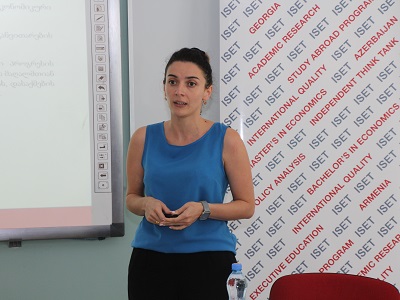On July 19, the APRC’s Salome Gelashvili presented the results of the study “Competitive advantages of mountainous regions of Georgia” to representatives of both state and civil society organizations. The study was conducted in collaboration with the Georgian Institute of Public Affairs (GIPA) with financial support from theUnited Nations Development Program (UNDP), the Swiss Agency for Development and Cooperation (SDC), and the Austrian Development Cooperation (ADC).
The goal of the research project was to support the elaboration of informed and evidence-based regional policies aimed at the development of mountainous regions of Georgia. In order to achieve this goal, the primary objective of the study was to identify gravity centers and functional regions in Georgia, as well as priority economic activities and sectors with high potential for economic growth in mountainous areas. The research team studied factors affecting the competitiveness of the prioritized sectors and developed recommendations for local and central government representatives.
The research shows that cities in mountainous regions of Georgia are not sufficiently developed to be gravity centers for other municipalities. Currently, gravity centers with the biggest functional regions coincide with the largest cities of Georgia (namely Tbilisi, Kutaisi, Zugdidi, Batumi and Telavi) while potential gravity centers such as Ambrolauri, Akhalkalaki, Tianeti, Tsalka and Shuakhevi suffer from low rural development, resulting in an outflow of the local population to the gravity centers. The only exception is Mestia, where investments in tourism sector have been shown to be the major drivers of the region’s economic development.
Functional regions united by respective gravity centers do not always coincide with administrative regions, and development policies should take this fact into account.
According to the research, the hotel and dairy industries are the major drivers of economic growth in the alpine regions of Georgia. While these sectors are relevant for most of the mountainous regions, they are also closely connected to each other; both of them face challenges related to the lack of local competent human resources, as well as limited infrastructure. Taking into consideration the sectoral recommendations, which promote the relevant sectors, the development of the country’s mountainous regions must still be integrated with territorial development and must not concentrate solely on a single sector. It is therefore necessary to use integrated approaches for the development of the whole functional region, rather than a specific municipality. This will contribute to the sustainable development of the region.
The presentation was followed by a Q&A session and a lively discussion.











